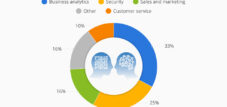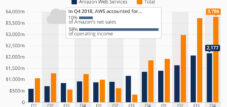Skype for Business & Co
Language selection 📢
Published on: June 2, 2015 / update from: November 26, 2018 - Author: Konrad Wolfenstein
Video communication in Industry 4.0 & logistics
Video telephony has been a popular tool for years, not just for private conversations. But even at business events, important conversations, meetings and presentations are increasingly being held online - especially if long distances have to be bridged between the participants. The advantages in terms of cost and time savings are obvious. However, there are also other reasons for using this digital communication channel in daily business.
Skype 4 Business – Microsoft’s answer to the trend
With its one billion users (2013) and a forecast of almost two billion in 2021, Skype by far the largest player in the area. It is now estimated that a third of all international phone calls are made via the service, which was purchased from Microsoft for $8.65 billion. A large part of the communication has so far been on a private level. Something Microsoft wants to change. For this reason, they recently merged their communication network Lync , one of the most widely used systems for business video calling and conferencing, with Skype and named it Skype for Business .
Since the security aspect of communication is particularly important in business transactions, Microsoft strives to protect the chats particularly compared to the standard Skype version. This is done with multi-factor authentication and encryption. Companies should also be able to manage accounts for their employees in which individual functions can be activated separately.
Skype for Business is integrated into Office 365 and the associated servers, which Microsoft expects to provide additional security. Optionally, companies can also set up the service in a hybrid cloud solution. Of course, the Skype solution is not the only alternative, as there are a large number of other providers that also focus on business communication. This is made easier by the Internet standard WebRTC , which enables video conferences directly between users of web browsers without the users having to first install or purchase a special client from, for example, Skype and the associated services from Microsoft. Last but not least, it is these platform-independent, cloud-based solutions that are ensuring the increasing spread of the technology.
Advantages
The most common reason for the use of interactive video communication is the savings potential for time and money. But as early as 2007, the industry analyst IDC came in the study “Seeing is Believing: The Value of Video Collaboration” about the use of video in companies for the following results:
- By accelerating decision-making processes, companies increase their productivity by an average of 30 percent
- Collaboration between video-connected departments increases by 35 percent as video communication e.g. B. Cross-location contact is improved and employees feel more involved in decision-making processes
- Conflicts are resolved 75 percent faster because communication improves significantly due to the non-verbal component
In the manufacturing industry, however, developments often go even further. Because here the interest goes far beyond simply holding cross-location meetings and directly intervenes in the operational production and coordination processes. Areas of application would be, for example:
- With the help of video communication, manufacturing processes can be visually monitored across locations and work steps can be conveyed or optimized. Among employees, the learning effect through improved insight into how spatially separated teams work has a particular motivational and acceptance effect.
- Tasks such as superficial quality control can be carried out from a central workstation.
- For industries that operate with many, sometimes remote locations (e.g. in oil and gas production), experts involved can provide support and control at the same time in solving problems, diagnosing or optimizing processes.
- In the area of research & development and in the pharmaceutical industry in general, experiments, product tests and new developments can be carried out simultaneously at different locations and the results can be clearly compared.
- In logistics, parts of supply chain management can be controlled and monitored using video technology. In particular, the nature of raw materials, preliminary and finished products on their sometimes considerable journey from the producers via distribution warehouse to the end customer can be more easily controlled. If an error occurs, action can be taken quickly and, for example, when purchasing products from the Far East, there is no need to wait until the items arrive in the destination country and it may already be too late for a recall.
And if there are problems with the foreign language: To support multilingual conversations, Microsoft/Skype, among others, now offer simultaneous translators for better understanding.
Insight into production with smart glasses
The technology for transmitting videos does not always have to be housed on static devices or in the cameras of computers, which is a significant impairment, especially in mobile use.
The Fraunhofer Institute for Production Technology has developed intelligent data glasses that can help in production to operate machines, stack pallets correctly or establish direct contact with experts. The advantage of data glasses (also known as head-mounted displays, HMDs for short) is that, in addition to the data projected onto the display, the user can still perceive the surroundings with virtually no interference and has both hands available for other activities. In the future, the Fraunhofer Institute's software can support industrial companies in accelerating value-adding processes and sharing information across location boundaries in real time - in keeping with the spirit of globally networked Industry 4.0.
The data glasses include a camera for video and image recordings as well as a display. This means it is able to display all work steps quickly and directly at the workplace and also enable communication via video.
According to the Fraunhofer researchers, areas of application for the data glasses equipped with the new software are primarily in industry, where their use is particularly worthwhile in complex work processes. In addition, employees can access other useful tools during the ongoing process: For example, suggestions for improving the product or error messages no longer have to be laboriously documented in writing, but can be captured directly on the spot using image, video and voice recordings. Direct contact with developers or other areas is also possible via video telephony, so that acute problems can be solved together immediately.
Use of smart glasses in logistics
But the use of the handy devices makes sense not only in production. In intralogistics, the warehouse worker can be provided with data glasses whose display shows relevant data about his current order in real time. In addition, videos can also be played via the field of view to support the employee and at the same time allow him to interact with the person he is talking to. Another step towards networked logistics 4.0.
Examples of applications include:
- Recording of location, item number and number of parts to be grabbed
- Checking the grabbed item and assigning it for picking
- Video function for communication/support of the employee
In addition to increasing the precision and speed of work performance, the system has the disadvantage that it requires the employee to take a certain amount of time to get used to it and be willing to adapt to this technological change. The currently rather unwieldy size and weight of the devices could have a negative impact on acceptance.
However, as communication systems continue to develop, it can be assumed, as with the use of video technology in general, and not least due to preparatory work by Internet giants such as Google , Microsoft or Amazon , that the technology will play a significant role in the networked Industry 4.0 . What is certain is that the necessary technology is constantly evolving. Who knows, maybe in a few years we will be able to make video calls on the way to the office or from the café using smartwatches.






























